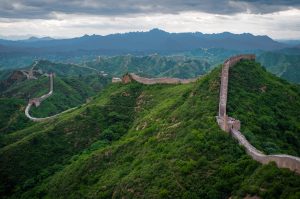Chapter 2 – Ancient Engineering
Great Wall of China – 700 BCE to 1600 CE
The Great Wall of China is an impressive engineering feat. It runs for more than 8000 kilometres from east to west from Mount Hu near Dandong, in Liaoning province, to Jiayu Pass west of Jiuquan in the northwester Gansu province. It is a series of fortification made of stone, brick, tamped earth, wood and other material.
https://www.britannica.com/topic/Great-Wall-of-China

It was built to protect the Chinese states and empires against the raids and invasions of the various nomadic groups of the Eurasian Steppe. Several walls were being built as early as the 7th century BCE, these were later joined together and made bigger and stronger, are collectively referred to as the Great Wall.
Especially famous is the wall built in 220–206 BC by Qin Shi Huang, the first Emperor of China. Little of that wall remains. The Great Wall has been rebuilt, maintained, and enhanced over various dynasties; the majority of the existing wall is from the Ming Dynasty (1368–1644 CE)
https://en.wikipedia.org/wiki/Great_Wall_of_China
It is one of the largest building-construction projects ever undertaken. The Great Wall actually consists of numerous walls—many of them parallel to each other—built over some two millennia across northern China and southern Mongolia. The most extensive and best-preserved version of the wall dates from the Ming Dynasty (1368-1644). This wall often traces the crests of hills and mountains as it snakes across the Chinese countryside. About one-fourth of its length consists solely of natural barriers such as rivers and mountain ridges. Nearly all of the rest (about 70 percent of the total length) is actual constructed wall, with the small remaining stretches being ditches or moats. Although lengthy sections of the wall are now in ruins or have disappeared completely, it is still one of the more remarkable structures on Earth.

